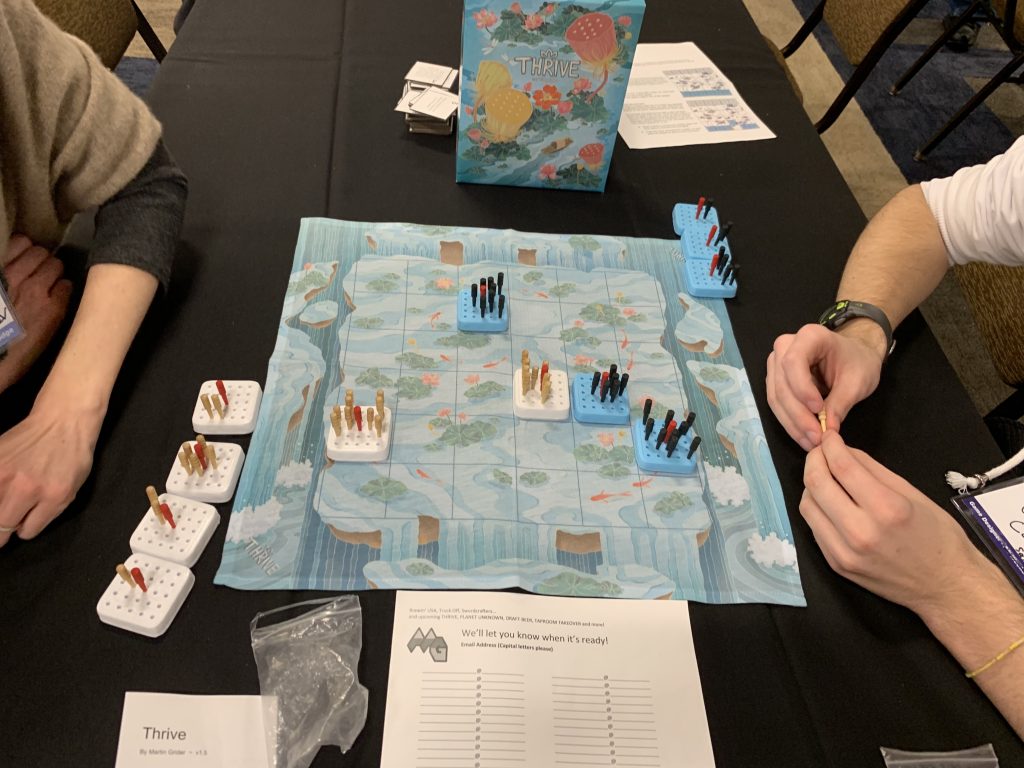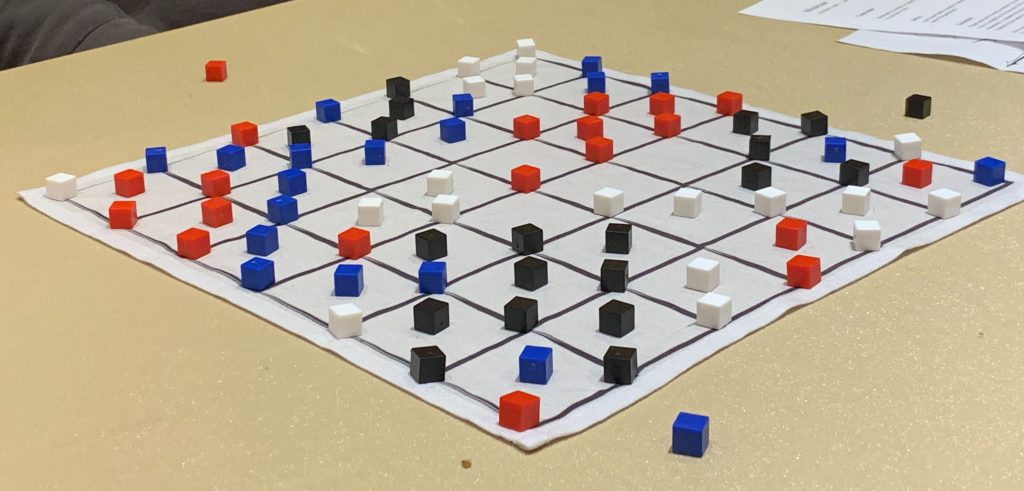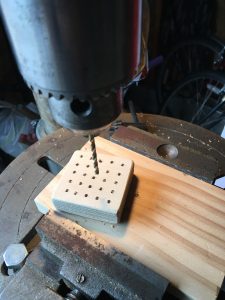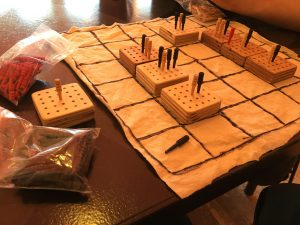As a VR developer, and self-professed Nintendo superfan, getting the Nintendo Labo VR kit was definitely a priority. I had the first couple of Labo kits, but I’ll be honest, I never even put together the giant robot one. (I’ll get around to it someday.)
My daughter and I spent an hour or two putting together the initial headset, and then checking out the 16 or so mini-games that are playable with just that. The headset itself feels a lot like google cardboard, but the larger screen size of the Nintendo Switch means the lenses are also really huge.
I think this also means it’s pretty forgiving in terms of eye placement in the headset. I took the kit to our local VR & HCI meeting earlier this week, and passed it around a bunch. Only one person mentioned they were having problems getting it to line up properly.
My daughter and I have probably also spent another 5 to 10 short (1/2 hr to 45 minute) sessions putting together various other accessories and playing their associated minigames. For some reason that felt quite a bit more satisfying than the original Labo kit, I think maybe because I have a natural tendency to want to only spend a minute or two at a time in 3DoF VR, and so the games feel like they are the appropriate length. And it helps that there are a lot of different experiences.
Additionally, I don’t know how to articulate this exactly, but I cannot stress enough how cool it feels to build your own VR accessory. In a way it feels like switching attachments in Budget Cuts or Cosmic Trip, but IN REAL LIFE, and you build the attachments yourself!
The camera attachment alone was easily an hour of assembly, and the underwater game you play with it (basically just pointing the camera at things and taking pictures) was pretty engaging for a good length of time. We also put together the blaster, (probably more like a 2 or 4 hour activity in total) and I think my daughter would have easily spent at least that long playing the alien shooter game it enables if I’d let her.
In general, I’ve found playing with someone else is a nice way to go about it, because, while in Build mode, it’s nice to have one person folding / assembling the cardboard, and the other person manning the forward button on the switch. And when playing, sessions longer than a minute or two definitely start to make me feel queasy. My daughter doesn’t seem to have that problem, but I’d still like to limit her usage, so taking turns makes sense.
So… I just this morning finished checking out the VR modes in Zelda and Mario Odyssey.
My short review of those: super underwhelming.
The camera still rotates around your character in Zelda, so moving my head at all made me feel pretty sick. You can still control the camera with the right stick, so it was playable if I kept my head still. After like a minute or two, my arms were tired, so I detached the joycons and played with my head tilted back and the Labo VR resting on my face. Made me wish for like a second it came with a headstrap, but it would be terrible, so makes sense that it doesn’t.
The edges of the screen had some chromatic aberration, which was most noticeable in the menus, which float in screen space, so you can’t turn your head to see the edges. Text was hard to read as well (although not as bad as I’d expected).
The whole game is playable in VR, so that’s something. But because the camera is essentially the same as in the normal game, it’s not like you can peer around and find new stuff. The only real novelty is stereoscopic 3D.
Mario wasn’t much better. Their game has the camera at a fixed point, and you HAVE to rotate the headset to look around. This doesn’t make me feel sick, really, but feels like a super low-rez way to play what is otherwise a good looking game. (For some reason, the low rez in Zelda didn’t bother me at all, but I wasn’t checking it out for very long…)
The gameplay in the mario levels (because that’s what they are, new smallish 3D levels, where the camera only rotates from a fixed point) was collecting musical instruments to give to the musicians scattered throughout. To get each instrument was basically the musical-note-fetch-quest that triggers by collecting the first note, (and then a bunch more notes appear to collect before a timer makes them disappear again). This is a mechanic already in the base game, typically with stars as a reward, and was rather disappointed it wasn’t a new game mode entirely. Especially because those are some of my least favorite types of stars to collect. And it’s worth noting you don’t even get stars for them here. You load up these new levels from the main menu, before you even pick a save slot.
You also have the option of playing the new levels without VR. But in that mode you CANNOT change the camera other than using the Nintendo Switch’s accelerometer. I was disappointed with the first level in VR, so I thought I’d try out the second one without it, and it definitely felt worse to me having to rotate the switch around to look anywhere, but without it attached to your face.
Overall, I am VERY pleased with my Nintendo Labo VR purchase. I just wouldn’t recommend getting it to play Zelda or Super Mario Odyssey. But there is a ton of content in the Labo kit itself. I still haven’t built the Elephant or Swan attachments, and I feel like I have a lot more content to explore even without them! I’m definitely looking forward to spending more time with Labo VR.







 I’m a huge fan of
I’m a huge fan of 
 Eigenstate is a 2-player abstract strategy game with incredibly simple rules that grows in complexity as you play.
Eigenstate is a 2-player abstract strategy game with incredibly simple rules that grows in complexity as you play.

 Notably, in this period of floundering around, I sat down with Patrick Leder (at GlitchCon a local game development conference here in MN), and also Nick Bentley (at Gencon 2016). I don’t think either of them were all that impressed, and around that time, I basically shelved the game for about a year after that.
Notably, in this period of floundering around, I sat down with Patrick Leder (at GlitchCon a local game development conference here in MN), and also Nick Bentley (at Gencon 2016). I don’t think either of them were all that impressed, and around that time, I basically shelved the game for about a year after that. In quantum physics, the term eigenstate refers to the possible movement of a particle. It’s a bit more complicated than that, of course, (and honestly, I have only a slippery grasp on the concept), but once I hit upon quantum physics (and in particular using the uncertainty principal as a metaphor for movement in the game), I began hunting around for suitable quantum physics terms. I think there’s a cool extended metaphor about each of the pieces being particles in a system, and the players competing to observe their opponent’s system first. How moving your own particles (pieces) helps you observe that system is left as a thought exercise for the player.
In quantum physics, the term eigenstate refers to the possible movement of a particle. It’s a bit more complicated than that, of course, (and honestly, I have only a slippery grasp on the concept), but once I hit upon quantum physics (and in particular using the uncertainty principal as a metaphor for movement in the game), I began hunting around for suitable quantum physics terms. I think there’s a cool extended metaphor about each of the pieces being particles in a system, and the players competing to observe their opponent’s system first. How moving your own particles (pieces) helps you observe that system is left as a thought exercise for the player.